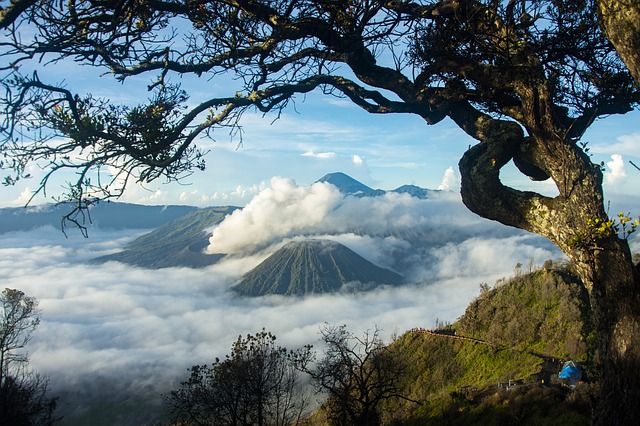A Hazy Future: The Problem With Air Pollution in Indonesia

 I was scrolling down my Facebook feed in mid-October when I saw some pictures of a parked airplane. The sky in the images was gray, curdled-looking; it was difficult to get a clear view of the runway. It looked like early morning, early evening.
I was scrolling down my Facebook feed in mid-October when I saw some pictures of a parked airplane. The sky in the images was gray, curdled-looking; it was difficult to get a clear view of the runway. It looked like early morning, early evening.
I stopped and read the announcement above it:
“It’s 12.30pm. The haze due to deforestation is unbelievable. I am leaving Palembang for now. As I board the plane, I am thankful I have the chance to leave but I feel terrible for Sumatra and all the people here. No one, no one deserves this.”
A shudder ran through me. I knew my friend had been having respiratory problems due to the thick haze engulfing Sumatra, but I hadn’t thought it would come to a health evacuation. Later, I messaged her for more details. She, an expat university instructor in English, explained to me that her health issues had started three days after her arrival for the school year in Palembang. She had an upper respiratory infection, which caused troubled breathing and an itchy, dry throat and nose. Her eyes had become red and teary.
What does it do to people’s mental well-being if for a large part of the year the sun is blurred behind a veil of pollution?
“Did I also mention severe coughing[?]” she typed.
This is my second year in Palembang, and the haze had not been this relentless last year. In conversations with natives of Palembang, the last time they remembered haze as thick was in 2008. This year, the seasonal rains, which usually wash the haze away took a longer time to arrive, due to the El Niño phenomenon.
Unfortunately, haze is a perennial problem in Indonesia during the dry season, musim kemarau, which runs from June to October. Haze, according to the publication DW, is “a type of dirty fog, in which ash and other particles caused by burning and pollution accumulate and create a thick, polluted low layer of dust in the atmosphere.”
The haze is primarily caused by burning used to clear large tracts of land for plantations, mostly wood fiber and palm oil. According to Andika Putraditama, a research analyst for the World Resources Institute, in an interview with DW, though fires may also be started by communities retaliating against companies in land disputes and from small fires grown out of control, the majority of them are believed to be linked to this wide-scale, illegal land-clearing.
The worst hit islands this year by far are Sumatra and Kalimantan, with South Sumatra, my province, bearing most of Sumatra’s detected hot spots (up to 170 at one point), spurring cloud-seeding and water-bombing operations to combat the fires.
My friend, Ryan, who is in his late twenties and is a native of the city, remembers a period of time in which his schooldays would start as late as nine in the morning because of how thick the haze could get.
Sumatra and Kalimantan aren’t the only places to suffer this haze; near-annually, Singapore and Malaysia, Indonesia’s closest neighbors, complain about how the haze rolls over their shores and engulfs their cities in choking haze (though there are rumors that some of the plantations are owned by Malaysian and Singaporean companies). Finally, twelve years after signing the ASEAN Agreement on Transboundary Haze Pollution, Indonesia’s parliament finally ratified it on Sept. 16, offering hope that greater regional cooperation and accountability will spur a more concerted, organized, and sustainable effort to defeat the haze once and for all.
But, for now, that hope is in the distant future. In the meantime, average residents must figure out ways to live with the haze with minimum damage. For many of my friends in Palembang, the annual haze goes back as far as they can remember. My friend, Ryan, who is in his late twenties and is a native of the city, remembers a period of time in which his schooldays would start as late as nine in the morning because of how thick the haze could get.
A Hazy Future: The Problem With Air Pollution in Indonesia.
Education, unfortunately, continues to be adversely affected by the haze a generation later. The school of my friend Emily, for instance, who is a second-year Fulbright English teaching assistant in Palangkaraya, Central Kalimantan, had been regularly canceling schooldays because of the ferocity of the haze.
“In Palangkaraya, it’s bad,” she said. “I haven’t seen the sun for a month[. . .] For a while, I forgot what the sun looked like.” She told me that the haze has been thick since her arrival in September and had only recently been lightening due to rainfall. Until then, her high school had been canceling up to three schooldays a week, leading to a significant loss of precious educational time.
The middle school I assist in, meanwhile, had shortened its day by at least thirty minutes so that the students didn’t have to suffer the effects of the haze too long everyday. One class I was teaching in was interrupted one day by students bearing boxes of medical masks. The haze was especially thick that morning, coupled with an acrid smell that prickled my nostrils, and one masked teacher shook her head and murmured, “Ammonia,” when I commiserated with her. When I asked an administrator how long they expected this reduced schedule to last, she said maybe until November.
Emily, who calls herself an “active person,” is unable to go outside to run. Road visibility is bad, and she, like other avid outdoors athletes, are cautious of what longterm exposure to the haze can do to their health.
Of course, lung issues seem to predominate in the wake of the haze. Local governments regularly hand out medical masks during haze season in addition to ordering people to stay indoors if necessary. In mid-March, Dr. Ajisman Syafaat, a lung specialist in Arifin Achmad state hospital in the Sumatran city of Pekanbaru, was reported by The Straits Times, to be appealing the city’s municipal administration to evacuate pregnant women, babies, and toddlers until the haze abated.
There are other costs to health, though. Emily, who calls herself an “active person,” is unable to go outside to run. Road visibility is bad, and she, like other avid outdoors athletes, are cautious of what longterm exposure to the haze can do to their health.
“It’s always depressing,” she also notes, which highlights a less-discussed health aspect of the haze: mental health. What does it do to people’s mental well-being if for a large part of the year the sun is blurred behind a veil of pollution? If it’s difficult to breathe? If this haze happens every year, and there doesn’t seem to be anything stopping it?
Recently, suffering a cold I hoped was unrelated to the haze (although the concentrated air pollution in Indonesia, at the least, didn’t help), I went to the apotek, the pharmacy. After ordering cold medicine, I thought to ask for medical masks.
This is a country that is ranked 114 out of 177 countries on the Corruption Perceptions Index conducted by Transparency International, after all.
The pharmacist took out a box crammed with masks. “Seribu,” he said. One thousand rupiah. About ten cents per mask.
I got seven and pondered whether it would be worth buying the cute masks I’ve seen people sporting all over the city, sturdier fabric ones embroidered or printed with monkeys, Spongebob and other colorful designs. Buying it though would seem like admitting defeat, that I didn’t think the haze was going anytime soon, even though South Sumatran officials themselves seemed to have given up hope and were reported by The Jakarta Post to have held a community prayer for rain, shalat istisqa, at City Hall on Oct. 14, in which thousands attended.
Many Indonesians are unimpressed with government handling of the fires and haze. Rumors fly that officials as high up as provincial governors own the land-burning plantations in question. While I can’t verify these claims, they do point to a wider dissatisfaction with the government’s response to the haze, a belief that institutional corruption more than likely allows these fires to continue, and a widespread feeling of powerlessness.
As Emily pointed out, the people around her feel limited to complaining and praying, as opposed to taking or pushing for direct action against the plantations who start fires. How can they, if it seems like the government and big business are in cahoots, as they are in many aspects of Indonesian politics and society? This is a country that is ranked 114 out of 177 countries on the Corruption Perceptions Index conducted by Transparency International, after all.
It was late October, about a week after my friend posted on Facebook, when the rain finally came.
I got seven and pondered whether it would be worth buying the cute masks I’ve seen people sporting all over the city, sturdier fabric ones embroidered or printed with monkeys, Spongebob and other colorful designs
I was sitting in a car with a couple of friends, ready to head to the mall for a movie, when I noticed something strange about the now totally normal gray sky outside.
“Is that. . .rain?” I asked.
We watched, hopeful, as the rain started to splatter the windshield. It wasn’t strong, the Indonesian rainstorms I’d gotten used to were usually more robust, but it was rain. I cheered. “Maybe the haze will go away!” I exclaimed.
That hasn’t quite happened yet. The haze returned but more sporadically; more frequently, the daytime is hot and clear with a color to the sky that, if not quite a healthy blue, at least does not resemble ash, smoke, or other unclean things. We even got a for-real thunderstorm the other day, powerful enough to cause mati lampu, a blackout, which both terrified and exhilarated me because even if it was scary to hear thunder and for the lights to keep going out, at least it was a stronger sign of more cleansing rain to came.
I still don’t go outside very much during the day, but it’s more often because of the average, blessed, midday Indonesian sun, not because the air is unbearably gritty and close, leaving a sour aftertaste in my nose and throat.
By this time next year, my contract will be finished, and it’s highly possible that I’ll be elsewhere, no longer smothered by this seasonal haze. If I’m in America, despite its own spotty environmental track record, due to the Clean Air Act, I can at least be sure that I can see more than a few yards ahead of me, that day will be recognizable from night, that I can breathe.
In the longterm, many of us expats will move back home or elsewhere, escaping annual exposure to this tightly condensed airborne layer of dirt, ash, and who knows what else.
But that’s not going to be true for millions of people in Indonesia, Malaysia, and Singapore. That’s not going to be true for my friends, the generous people who’ve welcomed me to this country, this city, and made it home. Foreigners who live in Palembang and have adverse reactions to the haze can leave the city for greener, fresher pastures; my friend got to go to Bali to recuperate after all. In the longterm, many of us expats will move back home or elsewhere, escaping annual exposure to this tightly condensed airborne layer of dirt, ash, and who knows what else.
Indonesians and other longtime residents do not; they have obligations and lives to attend to and often don’t have the time and finances to leave even if the haze reaches truly hazardous levels. So, every year, they must stock up on masks, start up their air purifiers, and prepare for disruptions to their schedules, prepare for gray skies and dim light, prepare for the haze to descend upon their homes with all its smothering consequences, known and unknown.
A Hazy Future: The Problem With Air Pollution in Indonesia photo by Pixabay.









One thought on “A Hazy Future: The Problem With Air Pollution in Indonesia”